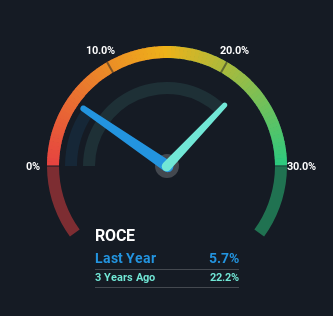Guangdong Skychem Technology (SHSE:688603) Will Want To Turn Around Its Return Trends
To find a multi-bagger stock, what are the underlying trends we should look for in a business? Amongst other things, we'll want to see two things; firstly, a growing return on capital employed (ROCE) and secondly, an expansion in the company's amount of capital employed. If you see this, it typically means it's a company with a great business model and plenty of profitable reinvestment opportunities. However, after briefly looking over the numbers, we don't think Guangdong Skychem Technology (SHSE:688603) has the makings of a multi-bagger going forward, but let's have a look at why that may be.
What Is Return On Capital Employed (ROCE)?
For those who don't know, ROCE is a measure of a company's yearly pre-tax profit (its return), relative to the capital employed in the business. To calculate this metric for Guangdong Skychem Technology, this is the formula:
Return on Capital Employed = Earnings Before Interest and Tax (EBIT) ÷ (Total Assets - Current Liabilities)
0.057 = CN¥64m ÷ (CN¥1.2b - CN¥38m) (Based on the trailing twelve months to March 2024).
Therefore, Guangdong Skychem Technology has an ROCE of 5.7%. On its own, that's a low figure but it's around the 5.5% average generated by the Chemicals industry.
Check out our latest analysis for Guangdong Skychem Technology

Above you can see how the current ROCE for Guangdong Skychem Technology compares to its prior returns on capital, but there's only so much you can tell from the past. If you'd like, you can check out the forecasts from the analysts covering Guangdong Skychem Technology for free.
What The Trend Of ROCE Can Tell Us
On the surface, the trend of ROCE at Guangdong Skychem Technology doesn't inspire confidence. Around three years ago the returns on capital were 22%, but since then they've fallen to 5.7%. Meanwhile, the business is utilizing more capital but this hasn't moved the needle much in terms of sales in the past 12 months, so this could reflect longer term investments. It's worth keeping an eye on the company's earnings from here on to see if these investments do end up contributing to the bottom line.
On a side note, Guangdong Skychem Technology has done well to pay down its current liabilities to 3.3% of total assets. So we could link some of this to the decrease in ROCE. Effectively this means their suppliers or short-term creditors are funding less of the business, which reduces some elements of risk. Since the business is basically funding more of its operations with it's own money, you could argue this has made the business less efficient at generating ROCE.
What We Can Learn From Guangdong Skychem Technology's ROCE
Bringing it all together, while we're somewhat encouraged by Guangdong Skychem Technology's reinvestment in its own business, we're aware that returns are shrinking. Since the stock has declined 44% over the last year, investors may not be too optimistic on this trend improving either. All in all, the inherent trends aren't typical of multi-baggers, so if that's what you're after, we think you might have more luck elsewhere.
On a separate note, we've found 1 warning sign for Guangdong Skychem Technology you'll probably want to know about.
While Guangdong Skychem Technology isn't earning the highest return, check out this free list of companies that are earning high returns on equity with solid balance sheets.
New: Manage All Your Stock Portfolios in One Place
We've created the ultimate portfolio companion for stock investors, and it's free.
• Connect an unlimited number of Portfolios and see your total in one currency
• Be alerted to new Warning Signs or Risks via email or mobile
• Track the Fair Value of your stocks
Have feedback on this article? Concerned about the content? Get in touch with us directly. Alternatively, email editorial-team (at) simplywallst.com.
This article by Simply Wall St is general in nature. We provide commentary based on historical data and analyst forecasts only using an unbiased methodology and our articles are not intended to be financial advice. It does not constitute a recommendation to buy or sell any stock, and does not take account of your objectives, or your financial situation. We aim to bring you long-term focused analysis driven by fundamental data. Note that our analysis may not factor in the latest price-sensitive company announcements or qualitative material. Simply Wall St has no position in any stocks mentioned.
Have feedback on this article? Concerned about the content? Get in touch with us directly. Alternatively, email editorial-team@simplywallst.com
About SHSE:688603
Shanghai Skychem Technology
Engages in research and development, production, and sales of functional wet electronic chemicals.
Flawless balance sheet with high growth potential.
Market Insights
Community Narratives



